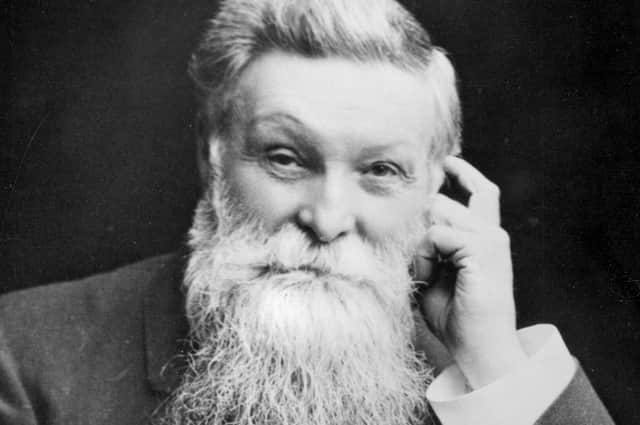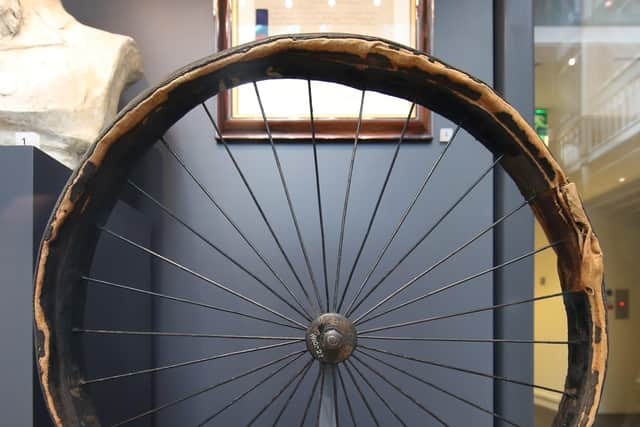John Boyd Dunlop didn’t invent pneumatic tyre ... yet everyone thinks he did


John Boyd Dunlop was an Ayrshire-born veterinary surgeon and graduate of the University of Edinburgh.
He was born prematurely on February 5 1840 on a farm near Dreghorn, son of John Dunlop and Agnes Dunlop (née Boyd).
Advertisement
Hide AdAdvertisement
Hide AdConsidered a delicate child, he was allowed to continue studies at Irvine Academy. At the age of 19 he graduated from the Royal Veterinary College, Edinburgh (commonly known as the ‘Dick Vet’ after its founder, William Dick). For eight years he worked in Edinburgh.


In 1867 he moved to Downpatrick, Co Down, and, in partnership with his brother, established Downe Veterinary Clinic there. He subsequently moved to Belfast and established a practice at 50 Gloucester Street, off May Street. By the mid 1880s, it was one of the largest veterinary practices in Ireland because of its close proximity to the Markets where farm animals were bought and sold.
Furthermore, in that era Belfast’s streets were filled with horse-drawn transport of every description.
Dunlop’s work involved a considerable amount of travelling over roads that were often very rough, something made still more uncomfortable by the fact that wheels on carriages had rims of iron or wood. But it was the cobbled streets of Belfast, and his son’s difficulty learning to ride a tricycle with solid rubber tyres, that gave rise to Dunlop’s brainwave.
Advertisement
Hide AdAdvertisement
Hide AdIn October 1887 Dunlop developed the first practical pneumatic or inflatable tyre for his son’s tricycle and, using his knowledge and experience with rubber, in the yard of his home in Belfast fitted it to a wooden disc 96cm across. The tyre was an inflated tube of sheet rubber.
He then took his wheel and a metal wheel from his son’s tricycle and rolled both across the yard together. The metal wheel stopped rolling but the pneumatic continued until it hit a gatepost and rebounded.
Dunlop then put pneumatics on both rear wheels of the tricycle. That too rolled better and Dunlop moved on to larger tyres for a bicycle ‘with even more startling results’. He tested that in Cherryvale sports ground, south Belfast, and a patent was granted on December 7 1888.
Unknown to Dunlop another Scot, Robert William Thomson (1822–1873) of Stonehaven had previously patented a pneumatic tyre.
Advertisement
Hide AdAdvertisement
Hide AdThomson’s patents for pneumatic tyres were taken out in 1846 and 1847 in France and the USA respectively. They describe a hollow rubber tube surrounded by leather and inflated by air.
Yet he was defeated by that fact that rubber production was still in its infancy and he just could not manufacture his invention to work at a cost-effective price.
Returning to Dunlop, on May 18 1889, local cyclist Willie Hume (1862-1941) took part in a series of races at the site of the old North of Ireland Cricket Club grounds, on the Ormeau Road. Hume was the captain of the Belfast Cruisers Cycling Club and Dunlop persuaded him to use his pneumatic tyres in the races that day, the first time such tyres were used in a competitive event anywhere in the world. Although not a particularly skilled cyclist, Hume managed – thanks to Dunlop’s invention – to win all four cycling events that day.
Among the losers that day were sons of the president of the Irish Cyclists’ Association, Harvey du Cros, a paper manufacturer.
Advertisement
Hide AdAdvertisement
Hide AdRecognising a business opportunity, du Cros established a personal association with Dunlop and together they set up a company which acquired the rights to his patent.
Two years after he was granted the patent, Dunlop was officially informed that it was invalid because Thomson had already patented the idea in France in 1846 and in the US in 1847.
To capitalise on pneumatic tyres for bicycles Dunlop and du Cros revived a Dublin-listed company and renamed it Pneumatic Tyre and Booth’s Cycle Agency. Dunlop retired in 1895. In 1896 du Cros sold their whole bicycle tyre business to a British financier for £3 million. The company was resold to the public for £5 million. Du Cros remained head of the business until his death. Early in the 20th century the company was renamed Dunlop Rubber.
Although Dunlop strictly speaking was not the inventor of the pneumatic tyre, just about everyone who has heard his name believes that he did.
Advertisement
Hide AdAdvertisement
Hide AdAdmittedly some Americans imagine that Charles Goodyear (1800-60) invented the pneumatic tyre but his achievement was to invent and patent the process of vulcanisation.
Dunlop made comparatively little money from his ‘invention’ because he retired too early and the advent of the motor car came too late for him.
Dunlop lived in Ballsbridge, Dublin, from 1892, and was director of Todd Burns, the Dublin drapery firm.
If Dunlop was not a hypochondriac, he certainly behaved like one. Yet he had a long life, dying unexpectedly from a slight chill in Dublin on October 23 1921.
Advertisement
Hide AdAdvertisement
Hide AdIn 1876 he had married Margaret Stevenson from Ballymena, Co Antrim. Their only son died in 1920; they also had a daughter.
A blue plaque at 38-42 May Street in Belfast commemorates John Boyd Dunlop’s connection with the pneumatic tyre on the site where he developed his ‘invention’. Examples of bicycles fitted with pneumatic tyres may be seen in both the Ulster Museum and the Ulster Folk and Transport Museum. What purports to be his first tyre is on display in the National Museum of Scotland.
In August 1990 the Northern Bank issued a £10 note featuring John Boyd Dunlop. These notes, now issued by the Danske Bank, are still in circulation.